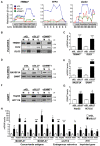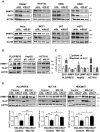The splicing regulator SLU7 is required to preserve DNMT1 protein stability and DNA methylation
- PMID: 34331453
- PMCID: PMC8421144
- DOI: 10.1093/nar/gkab649
The splicing regulator SLU7 is required to preserve DNMT1 protein stability and DNA methylation
Abstract
Gene expression is finely and dynamically controlled through the tightly coordinated and interconnected activity of epigenetic modulators, transcription and splicing factors and post-translational modifiers. We have recently identified the splicing factor SLU7 as essential for maintaining liver cell identity and genome integrity and for securing cell division both trough transcriptional and splicing mechanisms. Now we uncover a new function of SLU7 controlling gene expression at the epigenetic level. We show that SLU7 is required to secure DNMT1 protein stability and a correct DNA methylation. We demonstrate that SLU7 is part in the chromatome of the protein complex implicated in DNA methylation maintenance interacting with and controlling the integrity of DNMT1, its adaptor protein UHRF1 and the histone methyl-transferase G9a at the chromatin level. Mechanistically, we found that SLU7 assures DNMT1 stability preventing its acetylation and degradation by facilitating its interaction with HDAC1 and the desubiquitinase USP7. Importantly, we demonstrate that this DNMT1 dependency on SLU7 occurs in a large panel of proliferating cell lines of different origins and in in vivo models of liver proliferation. Overall, our results uncover a novel and non-redundant role of SLU7 in DNA methylation and present SLU7 as a holistic regulator of gene expression.
© The Author(s) 2021. Published by Oxford University Press on behalf of Nucleic Acids Research.
Figures









Similar articles
-
SLU7: A New Hub of Gene Expression Regulation-From Epigenetics to Protein Stability in Health and Disease.Int J Mol Sci. 2022 Nov 2;23(21):13411. doi: 10.3390/ijms232113411. Int J Mol Sci. 2022. PMID: 36362191 Free PMC article. Review.
-
Splicing events in the control of genome integrity: role of SLU7 and truncated SRSF3 proteins.Nucleic Acids Res. 2019 Apr 23;47(7):3450-3466. doi: 10.1093/nar/gkz014. Nucleic Acids Res. 2019. PMID: 30657957 Free PMC article.
-
The USP7/Dnmt1 complex stimulates the DNA methylation activity of Dnmt1 and regulates the stability of UHRF1.Nucleic Acids Res. 2011 Oct;39(19):8355-65. doi: 10.1093/nar/gkr528. Epub 2011 Jul 10. Nucleic Acids Res. 2011. PMID: 21745816 Free PMC article.
-
A role for LSH in facilitating DNA methylation by DNMT1 through enhancing UHRF1 chromatin association.Nucleic Acids Res. 2020 Dec 2;48(21):12116-12134. doi: 10.1093/nar/gkaa1003. Nucleic Acids Res. 2020. PMID: 33170271 Free PMC article.
-
HAUSP Is a Key Epigenetic Regulator of the Chromatin Effector Proteins.Genes (Basel). 2021 Dec 24;13(1):42. doi: 10.3390/genes13010042. Genes (Basel). 2021. PMID: 35052383 Free PMC article. Review.
Cited by
-
SLU7: A New Hub of Gene Expression Regulation-From Epigenetics to Protein Stability in Health and Disease.Int J Mol Sci. 2022 Nov 2;23(21):13411. doi: 10.3390/ijms232113411. Int J Mol Sci. 2022. PMID: 36362191 Free PMC article. Review.
-
Caspases compromise SLU7 and UPF1 stability and NMD activity during hepatocarcinogenesis.JHEP Rep. 2024 May 9;6(8):101118. doi: 10.1016/j.jhepr.2024.101118. eCollection 2024 Aug. JHEP Rep. 2024. PMID: 39105183 Free PMC article.
-
Regulatory mechanism and biological function of UHRF1-DNMT1-mediated DNA methylation.Funct Integr Genomics. 2022 Dec;22(6):1113-1126. doi: 10.1007/s10142-022-00918-9. Epub 2022 Nov 14. Funct Integr Genomics. 2022. PMID: 36372834 Review.
-
The Role and Mechanism of the Histone Methyltransferase G9a in Tumors: Update.Onco Targets Ther. 2024 May 30;17:449-462. doi: 10.2147/OTT.S451108. eCollection 2024. Onco Targets Ther. 2024. PMID: 38832355 Free PMC article. Review.
References
-
- Baylin S.B., Esteller M., Rountree M.R., Bachman K.E., Schuebel K., Herman J.G.. Aberrant patterns of DNA methylation, chromatin formation and gene expression in cancer. Hum. Mol. Genet. 2001; 10:687–692. - PubMed
-
- Strahl B.D., Allis C.D.. The language of covalent histone modifications. Nature. 2000; 403:41–45. - PubMed
-
- Bird A.DNA methylation patterns and epigenetic memory. Gene Dev. 2002; 16:6–21. - PubMed
Publication types
MeSH terms
Substances
LinkOut - more resources
Full Text Sources
Molecular Biology Databases
Miscellaneous

